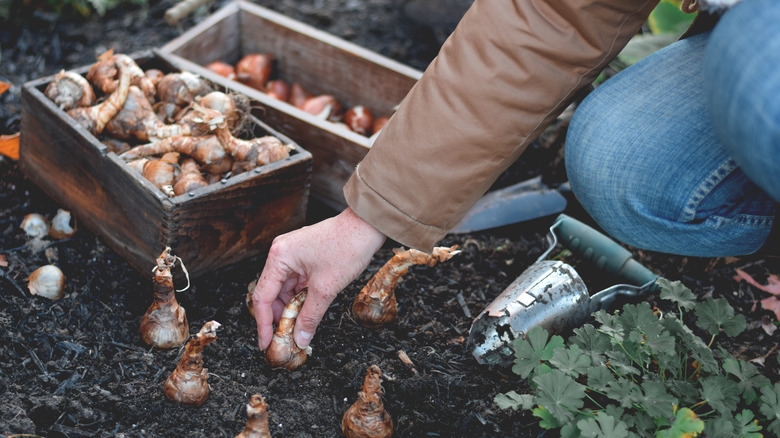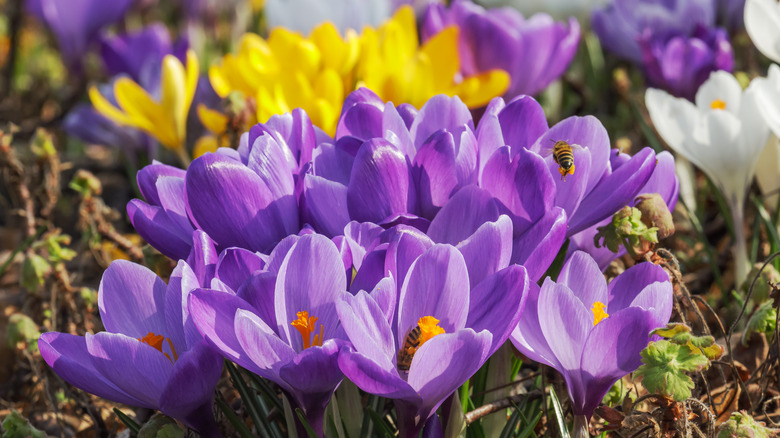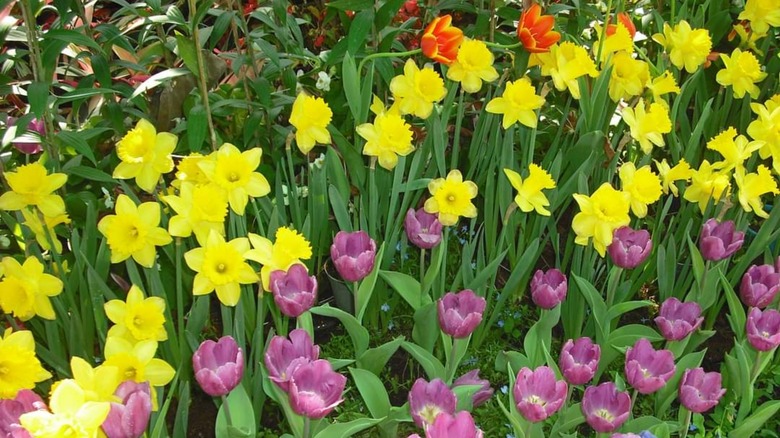How To Strategically Plant Bulbs In Fall For Maximum Bloom Appeal In Spring
There is perhaps no more exciting time in the flower garden than spring, when new growth emerges and rejuvenates the land (and our moods) after the cold, dark days of winter. Blooming bulbs are a delightful way to welcome spring to the garden, and once they're planted, they need little care other than dividing occasionally. To create a dramatic display with your spring bulbs, it's best to plant them strategically, based on their height, color, and the timing of when they bloom.
Before planting, decide how you want your spring flower bed to look. Do you want many different colors, or a specific color palette? Do you prefer certain varieties of flowers to others? Do you want fragrant flowers? Considering these questions will help you choose your bulbs. Many gardeners start ordering bulbs in late summer to get a head start before supplies run out. Others may head to the nursery right before planting and take their chances. Maybe you do a combination of both. Either way, looking at bulb catalogs or websites can help you plan for which bulbs to buy.
Next, familiarize yourself with the bloom times of bulbs you wish to plant. Some bulbs bloom very early (snowdrops, scilla, Glory of the Snow, daffodils), while others flower in mid-spring (hyacinths, daffodils, tulips) and some in late spring (muscari, tulips, alliums). Knowing this timing is crucial to designing your spring bulb garden, as well as knowing how big the blooms will get and what colors they come in.
Which bulbs to plant where
In addition to the timing of blooms, you want to keep in mind how tall your spring flowers will be and how much space they take up, so you can plant them in the best spot. You may also decide to plant them next to other perennials, which is another reason to keep in mind how tall or wide they will get, and when they will bloom. For example, hellebores bloom very early and columbines bloom closer to mid-spring, so you can plant your bulbs near or among them to add to your spring display.
If you have large clumps of daffodils, they may be visible from a distance once they bloom, so you can plant them a bit further from the front of your border if desired. The same is true for tulips, especially if they're planted in large groups. Shorter-lived spring flowers such as hyacinths, muscari (grape hyacinths), Spanish bluebells, and dwarf irises (Iris reticulata) should be placed in front of taller ones for maximum visibility. Alliums bloom in late spring and tall ones can brighten the back of the border.
Some gardeners like to plant early blooming spring bulbs throughout the lawn, for a beautiful mass blooming effect that won't be in danger of being mowed over (since grass mowing shouldn't commence until late spring or summer). This method works well with bulbs that naturalize and spread, such as crocuses, scilla, Grecian windflowers, snowdrops, Glory of the Snow (chionodoxa), and striped squill (Puschkinia).
Consider color when planting
With spring bulbs providing weeks of color, you can easily design a dramatic garden display utilizing a number of approaches. Early-blooming bulbs like daffodils, scilla, snowdrops, and crocuses tend to come in pastel shades of yellow, white, blue, lavender, and pink. You can continue with this palette by planting later blooming bulbs like hyacinths and tulips in more shades of yellow, purple, and blue. Late blooming daffodils mixed with tulips look wonderful, for example.
You can also shift the color palette as spring progresses by adding brighter shades such as red, magenta, purple, and orange. Hyacinths come in all of these colors, though the yellows and oranges tend to be pastel rather than bright. Tulips come in virtually every color except blue, and some even have streaks of green (mainly the Greenland/Viridiflora varieties). Grape hyacinths add bright pops of violet and blue; there are also pale blues (like Valerie Finnis or Baby's Breath), and deep Navy blue (Paradoxum). These can be planted in small groupings or clumps in front of tulips for extra vibrant color.
Since many tulips only bloom once, these are a good choice to experiment with to add different colors to your spring garden. Maybe one year you will plant dark purple Queen of Night tulips near your pale pink and white hyacinths; then the following year, some hot pink tulips like Barcelona or Don Quichotte. Planting tulips in small clumps or rows of contrasting colors also creates a stunning, dramatic look.


